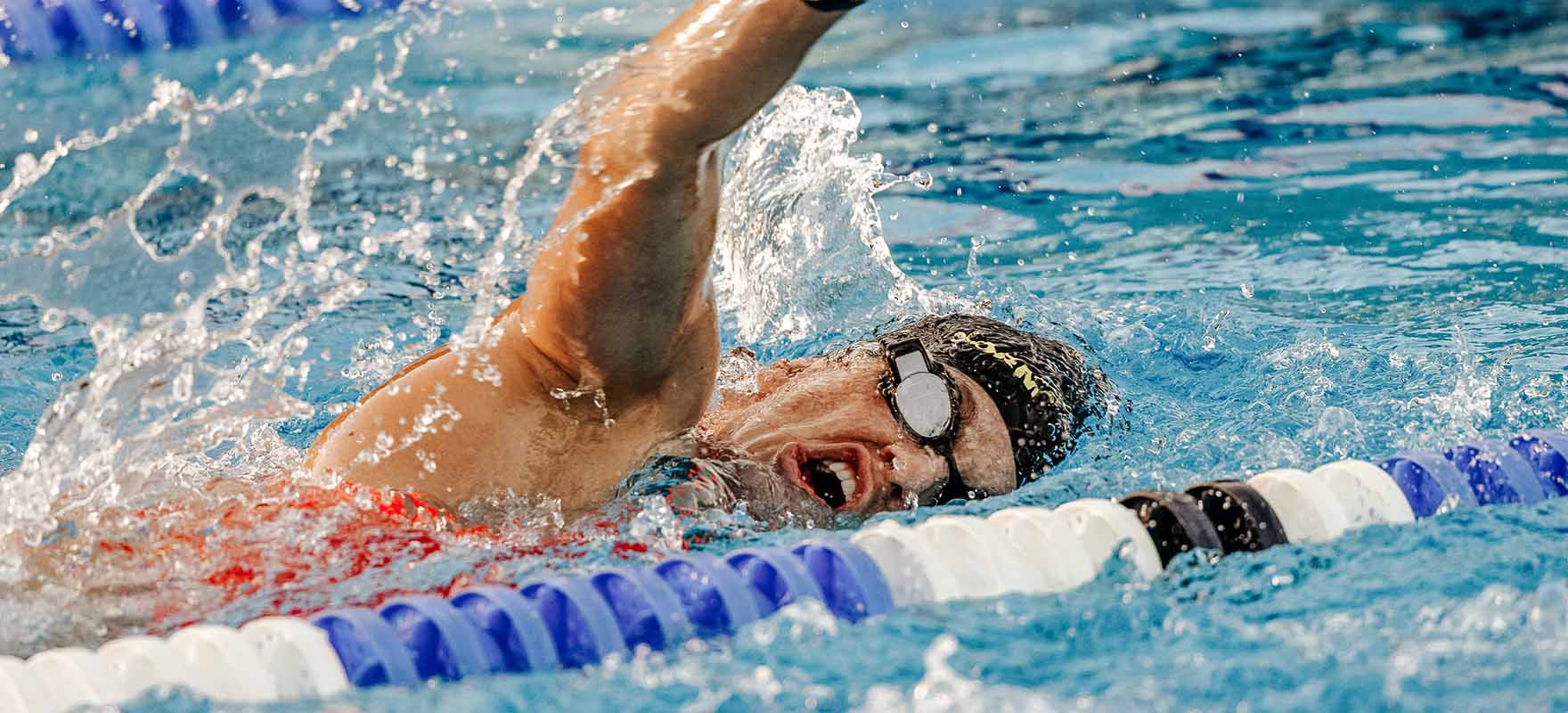7 Ways to Improve Your Swimming Breathing Technique
Most competitive swimmers want one thing: to be the fastest in their heat or final. And the key to making that happen is to improve your swimming breathing technique.
Even for beginner or intermediate swimmers, learning to improve your breathing can make a drastic difference with your comfort in the water—not to mention your speed and endurance.
The truth is that you can train your muscles, perfect your stroke, and even shave your entire body, but you may never reach your full potential if you neglect your breathing.
Bad breathing adds resistance to your swim and fatigues your body. But the better you are at breathing, the more oxygen you give to your body and the better you will perform.
Not sure where to start? Don’t worry. From strategies to exercises, drills, and tips, we’ve compiled all the information that competitive and experienced swimmers need to improve their swimming breathing technique.
The Right Swim Breathing Cadence
The first question you might wonder when it comes to your swimming breathing technique is how often you should be taking breaths.
This depends on a few variables, including the stroke you’re performing, how fast you’re going, and if you’re sprinting or swimming a long distance.
Many swimming styles allow you to choose when you breathe. For example, in a freestyle, you might choose to breathe every second, third, fourth stroke, or more. Others, like the butterfly, allow swimmers to breathe every one, two, or three strokes.
Ultimately, timing your breath to the rhythm of your stroke is favorable.
The Effects of Your Swim Breathing Technique on Your Speed
Your swimming breathing technique has a massive impact on your speed in the water because it affects your stroke and form.
Implementing more effective swimming breathing techniques and patterns will allow you to use fuller and more powerful strokes.
How to Improve Your Swimming Breathing Techniques
There’s one important thing to know right off the bat: there’s no instant solution to improving your swimming breathing technique.
Like anything in swim training, improving your breath control for swimming takes time, patience, and commitment.
But with that being said, these exercises, drills, strategies, and tips will help you breathe better and more efficiently in the pool and open water.
1. Use Bob Progression Drills
You can challenge your lungs and build their capacity by performing a simple bobbing exercise.
Here’s how it works.
Start by bobbing up to your hairline in the pool or open water, then progress deeper and for longer periods of time.
While you do so, focus on sustaining steady bubbles releasing from your nose. You can even release your breath from your mouth if you feel the need.
Takeaway: Perform this bob progression drill for as long as feels safe. Push yourself to go deeper and for longer each time you practice.
2. Swim with Proper Body Position
If you’re swimming with your head high and your hips low, you’re causing extra drag through the water and compromising your form each time you take a breath.
Practicing proper body position when you swim will allow you to maximize your breathing and stroke techniques as well as your speed.
If you find you’re sinking while breathing, a common mistake is that you may not be supporting your body while you breathe.
If you’re taking your breath and continuously pulling with the arm that’s in the water and opposite to the side that you’re breathing from, then you have nothing to use to support your body and keep it high in the water.
By leaving your arm extended out in front of you while you breathe, it helps you stay elevated in the water and supports your body by making it longer and, in turn, more balanced when distributing weight from your hands to your feet.
Leave your arm extended out in front as you breathe, and then as you begin to put your head back in the water, that’s the time to start your pull with that arm.
Takeaway: Work with a teammate or coach who can watch you and provide feedback to help you improve your form and swimming breathing technique in the water.
3. Practice Bilateral Breathing
When you’re swimming freestyle, it’s essential to practice bilateral breathing. This means breathing on odd strokes by alternating the side on which you take a breath.
This is an important skill to perfect in order to increase your performance in a swimming competition or a triathlon.
That’s because a bilateral swimming breathing pattern creates symmetrical and balanced strokes, making it easier to swim in a straight line, especially in open water.
It also trains you to feel comfortable breathing on both sides which is incredibly beneficial should you face challenges like having another swimmer splashing water into your face or having the sun in your eyes during an open water competition.
Takeaway: To execute a bilateral breathing pattern, you’ll want to adjust your inhale and exhale ratio to an “out-out-in” count. Despite this change, you’ll still want to maintain a movement of breath the entire time and not hold your breath at any time.
Note: Some short-distance lane competitors may choose to compete using unilateral breathing, but we strongly recommend incorporating bilateral breathing into your training to balance your strokes.
4. Exhale Forcefully
Fundamentally, breathing is a series of inhales and exhales. And when we think about rhythmic swimming breathing techniques, exhalation can sometimes get overlooked.
Many athletes complain about feeling winded during their swim and may believe this is due to oxygen debt or a shortened oxygen supply. In reality, the reason why you’re feeling winded is due to a buildup of carbon dioxide (CO2).
While the body uses oxygen as fuel, it produces CO2 as a byproduct that needs to be released. If you inhale big enough breaths to fill your lungs with oxygen but don’t exhale fully to reduce the buildup of CO2, you’ll continue to feel distressed throughout your swim.
To create a rhythmic swimming breathing pattern, try to mimic the way you breathe outside of the water. After all, you don’t walk down the street holding your breath and then try to take a burst breath when you feel discomfort.
Instead, you breathe in and out with that same natural rhythm when you’re in the water.
Takeaway: Practice exhaling forcefully through your nose and mouth to release CO2 buildup. Breathing should be fluid and rhythmic. Never pause or hold your breath.
5. Train with a Respirator
Whether you’re training for a 50-meter freestyle or a triathlon, a respiratory training device is an excellent exercise for training your swimming breathing technique that doesn’t even require putting your face in the water. You can use it on your off days when you’re away from the pool, lake, or ocean.
Using a respiratory training device has been described as, “weight training for your breathing muscles.” You can set the resistance on the device to make breathing more challenging. You may also choose to place a plug over your nose as you inhale and exhale through the mouthpiece.
One study found that swimmers who performed 30 repetitions on a respiratory training device twice daily decreased their 100-meter swim time by 1.7%.
Takeaway: Purchase a respiratory training device and incorporate it into your dryland training. Talk to your coach first to see how often they’d like you to use it. If not, follow along with the guidelines provided with your RPD.
6. Practice Diaphragmatic Breathing
Another technique to practice on dry land is the Diaphragmatic Breathing Technique (DBT), also known as belly breathing. This is achieved when your stomach, abdominal muscles, and diaphragm are all engaged while breathing.
Diaphragmatic breathing helps the lungs fill more efficiently and teaches you how to control your inhalation and exhalation while breathing.
Once you’ve mastered this technique on land, you can progress to using it in the water—first in training or during a workout, then ultimately in competition.
This method can help you perform better on race day and will also help you with recovery.
Takeaway: Ask your coach about DBT breathing. Start by practicing this method on dry land and progress to it in the water.
7. Incorporate Swimming Breathing Variation Drills
There are a ton of advanced swimming sets and intervals you can do to practice different variations of your swimming breathing techniques.
Here are a few you can try.
Varied Breathing Drills
Work on mixing up your breathing cadence over the course of four lengths.
For the first one, breathe on both sides. During the next length, breathe exclusively on one side. For your next length, breathe every three strokes. Then, on the last length, breathe in whichever way you choose.
Long Breathing Intervals
In order to train your diaphragm and increase your lung capacity, try doing lengths with longer intervals between breaths.
This could be breathing every five strokes or only breathing halfway through your length.
How long you swim between breaths will vary depending on your fitness and level of swimming experience.
Takeaway: Start lower with these drills and work your way up as you feel comfortable. Your goal should be to stretch your comfort zone in a safe way.
Improve Your Swimming Breathing Technique with FORM
Getting your swimming breathing technique takes time, dedication, and a strategic approach. But with the right guidance, the process becomes much simpler and more effective—and that’s where FORM comes in.
With FORM, you'll swim with real-time metrics right there in your goggles. Plus, get a free 2-month Premium and boost improvement in the pool with 1,000+ workouts, 30+ training plans, and a custom workout builder.
Backed by a 2-year warranty and 30-day return guarantee, FORM goggles are built to last.










